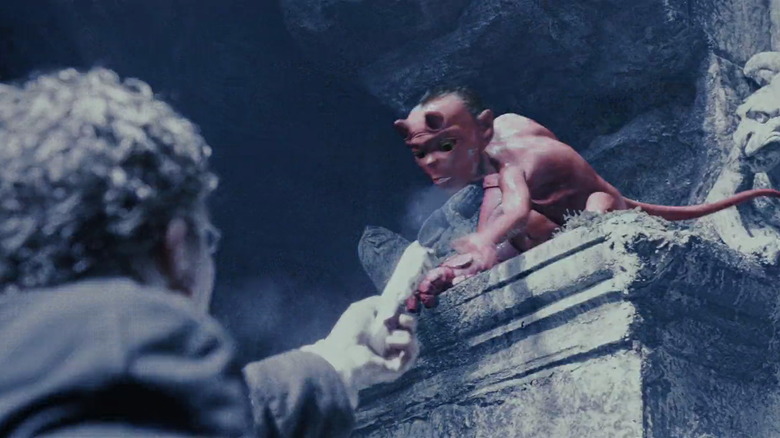This Is How The Hellboy Movie Differs From The Comic
In truth, we should probably all just be grateful that the Hellboy that wound up on the big screen in 2004 was anything like the one from Mike Mignola's line of comic books. Director Guillermo del Toro hasn't been shy about studio concerns regarding bringing a demonic antihero to the big screen, with some higher-ups making requests running the gamut from "could he be a normal guy that hulks out into a demon?" to "could he have a cute dog?" Through determination and persistence, the "Blade II" director managed to spare the world an adorable hellhound sidekick, in all likelihood named something like Brimstone or Devildog, though that last part is mostly speculation.
Even with del Toro swatting down swarms of revisionist concepts, the "Hellboy" movies weren't exactly superglued to their source material. Changes were made to adjust the tone and look of the films, and Mignola's high-contrast, low-light art style would've been nearly impossible to capture on film without full-on aping the look of "Sin City." Even the 2019 reboot, touted as being a comic accurate reimagining, took plenty of liberties with the denizens of the B.P.R.D.
Hellboy was rebuilt from the ground up
Right out of the gate, a few physical changes had to be made to Hellboy before he could make his big screen debut. In the comics, the character rocks a pair of blank yellow eyes, which is a tough sell visually. He also sported cloven hooves, which the filmmakers behind the 2004 adaptation realized early on would be difficult to pull off safely and convincingly. To add a layer of drama to the proceedings, he was kitted out with a new background, presented as a government secret — sort of a beefy, crimson member of the Men in Black. In the comics, he regularly interacted with the public, who weren't normally all that concerned with meeting a goliath from the depths of the underworld.
HB's origin story was also reconsidered. In the original "Hellboy" comic "Seed of Destruction," precious baby Anung Un Rama made his way to Earth through the sorcery of Gregori Rasputin, but his debut was a touch less dramatic. There was no firefight, for instance, and while there was a '40s era superhero present like in the 2019 Hellboy reboot, it wasn't the Lobster, but rather a Captain America-adjacent adventurer called Torch of Liberty. The Nazi forces behind the project were also miles away from where the bouncing bundle of demonic joy wound up materializing in front of his father figure, Professor Bruttenholm.
Speaking of, as wonderful a character as he was in the movies, played first by Kevin Trainor and John Hurt, then later by Ian McShane, the Professor's presence wasn't felt nearly as much in the comics. Hellboy's adoptive dad barely survived for a dozen pages in the comics before meeting his demise at the webbed hands of a terrible frog monster.
Hellboy's co-workers got a new coat of paint, too
The comic book version of Abe Sapien got a pretty remarkable overhaul on the path to the big screen. The first two "Hellboy" movies saw Abe (played by Doug Jones) stretching new muscles, psychically linking with people and objects through touch and diagnosing everything from the Professor's vaguely-defined illness to Liz's unannounced pregnancy. In the comics, he was more or less just a fish guy — a remarkable fish guy, transfigured by an occult ritual in the 19th century thanks to an elder god jellyfish, but not a particularly psychically gifted one. Also, he was plenty capable of walking around without a pair of lava lamps attached to his gills.
Selma Blair's Liz Sherman, meanwhile, was also put through a ringer, story-wise. While the plot beats of the character's life were left more or less intact, her relationship with Hellboy was more familial than romantic. Yes, in both the main-series comics and the Ron Perlman movies, we were deprived of seeing a bevy of cute-as-a-button pyrokinetic demon spawn. At least we still have Jack-Jack from "The Incredibles."
For what it's worth, change is hard, but it's also the only constant. Bucky started life in the "Captain America" comics as a child fighting in a World War. You can't take a crack at a multimedia franchise omelette without breaking a few canonical eggs.


